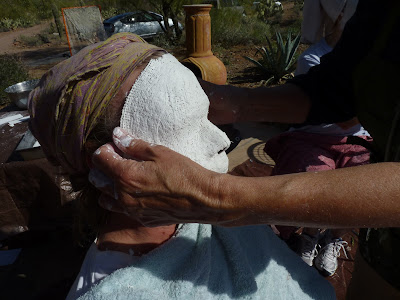I went to high school in Kabul, and although I have never been back to Afghanistan or Iran, where I also spent time, that part of the world is in my heart, and I try to keep informed. (AISK had a class reunion in 2003 - that would have been an experience!)"As if to help us change our perspective on war, discoveries within quantum physics suggest that the belief that we can achieve a position of dominance in relation to nature, life or each other is, ultimately, an illusion. Each of us is an expression of a vast sea or field of creative consciousness - invisible, and as yet barely recognised by us. We are all connected to each other through our participation in a great living web of life. It would seem that we are, literally, "our brother's keeper".
Anne Baring, "The Web of Life"
I felt like sharing some images about contemporary environmental art, and remembered a post in 2009. While surfing for "environmental art" I found the above photograph created by participants in an environmental arts festival in Iran, in 2007 (Iranian Radio) The story and images are also to be found at the Green Museum. I found the images so striking I wanted to share them again - I take the liberty of re-copying here.** And below, a show of contemporary environmental arts in 2010 at the University of Kabul. Amazingly, all participants are women, a stunning show of courage and creativity on their part.
 Color, Leaf, and Kavir:
Color, Leaf, and Kavir:Environmental Art Festival of Kerman
Nov 16, 2007
"The festival began in Vahdat Hall at Shahid Bahonar University in Kerman, with speeches and discussions on the concept of environmental arts.
"The participants were mainly from Kerman province coming from various universities. The initiative was taken by the scientific association of the painting course of the Saba Arts and Architecture School of Shahid Bahonar University. Environmental art festivals have been held during the last few years in various parts of the country. The Pardiss international center has created seven festivals. " (www.iranianradio.com/
By MUJIB MASHAL
“Area Pollution,” by Arezo Waseq, Center for Contemporary Arts, Kabul University.
KABUL, Afghanistan — For one week in June two auditoriums at Kabul University hosted a large exhibition on the themes of pollution and the environment. The exhibition had two remarkable qualities: All 18 participating artists were women, and the genre was modern art, a rarity in Afghanistan. Even today Kabul and Herat are the only Afghan provinces — out of 34 — to have a faculty of fine arts in their universities.
A collaborative piece titled “Fall in Spring,”
by Arefa Honryar, Zarghona Hotak, Sodaba Mehrayan, Sara Nabil and Arezo Waseq
In the 1990s came the Taliban. Music was banned, and art was limited to calligraphy and the drawing of immortal shapes........"When the Taliban left in 2001, we had seven professors and eight students in our department,” Professor Farhad said. "But in the past three years, the art scene has changed in terms of inclusiveness and creativity. Today, I have 700 students and close to 20 percent of them are girls. Quite often, I have to turn down students because we don’t have enough space for them,” Professor Farhad said, his eyes gleaming in triumph."“Health and Fission,” by Manizha Ahwad
"In the first couple of years of President Hamid Karzai’s government, the appearance of women on television was frowned upon. Television channels broadcast only male singers and artists. Gradually, the presence of women increased, but it cost the lives of several young women in the media to get there. Zakia Zaki, Sanga Amach and Shaima Rezayee are among the many female artists and presenters who were killed for the crime of appearing on television and trying to widen the role of women. Some female artists continue to battle the stigma, while others have turned to single-sex art centers that are more socially acceptable. The Center for Contemporary Arts — Afghanistan is one of these centers. Founded in 2004, it welcomed both male and female artists, but Mr. Omarzad soon realized that it was women who were most in need of a safe environment in which to work. For Environment Day, auditoriums at Kabul University were turned into galleries dedicated to the theme."‘Scream’, by Marzia Nazary
** some other environmental arts sites :
ecoartspace blog
Environmental arts (Orion Magazine) http://arts.envirolink.org/
Art + Environment
CSPA Connect
Deep Craft
Ear to the Earth
Earth Artists NetworkSEEDS
The Art of Engagement
























